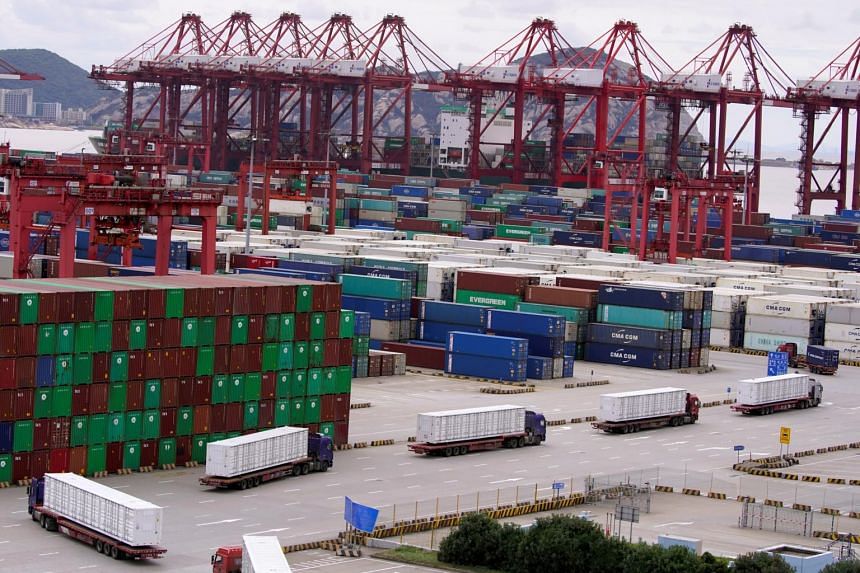China edges past Mexico as top US trade partner
Noi MahoneyMonday, December 7, 2020
China was the United States' top trade partner in October, accounting for almost $60 billion in imports and exports. (Photo: Jim Allen/FreightWaves)
China is again the top trading partner of the United States, with trade totaling $59.6 billion in October, according to data from the
U.S. Census Bureau.
China’s total trade with the U.S. rose 25% in October compared to the same month a year ago, with imports from China increasing 14% and U.S. exports to China increasing 51%.
Mexico fell to No. 2, as its total trade with the U.S. rose a moderate 0.57% to $53.66 billion in October, compared to the same period in 2019. Canada was third with $48 billion in total trade with the U.S. in October.
U.S. imports from Mexico rose 7% during October, compared to the same period in 2019. U.S. exports to Mexico declined almost 10% during October.
Ed Habe, vice president of Mexico sales at less-than-truckload (LTL) and logistics firm Averitt Express, said the trade imbalance between Mexico and the U.S. has affected cross-border operations for years.
“When it comes to transporting goods from Mexico to the U.S., the primary issue has been the ongoing imbalance,” Habe told FreightWaves. “There is much more freight needing to move from Mexico to the U.S. than vice versa. This issue makes it difficult and more expensive to consistently cover northbound loads.”
Cookeville, Tennessee-based
Averitt Express operates about 1 million square feet of distribution space at more than 20 locations in the Southeast and Midwest. The company recently
expanded its facility in Laredo, Texas.
Mexico’s trade with the U.S. has also been slowed by the struggling cross-border automotive and energy industries — from vehicles and parts to oil and fuels — which have been hit hard by the COVID-19 pandemic.
“Cross-border trade has always been dominated by automotive-related products,” Habe said. “With the new United States-Mexico-Canada Agreement [USMCA], this trend will continue to grow even stronger.”
U.S. imports of passenger vehicles from Mexico fell 27% during October to $23.34 billion. Imports of commercial vehicles fell 16% to $18 billion, and imports of auto parts declined 16% to $18 billion.
Habe added that carriers are seeing more diversification in cross-border shipments in recent years.
“Interestingly, aeronautic industries have sprouted up in different areas of Mexico such as Chihuahua and Queretaro. Appliances, including washing machines and refrigerators, are also coming out of Mexico to the U.S.,” Habe said. “The U.S. demand for Mexican food and beverages is increasing thanks to the growing Latino American consumer group.”
While Mexico’s trade with the U.S. was up slightly in October, it decreased 15% through the first 10 months of 2020 to $440 billion compared to the same period last year, according to a
WorldCity.
Since vehicles and auto parts make up a large part of cross-border shipments through Laredo, the port fell to No. 3 among the nation’s 450 airports, seaports and border crossings in October.
Port of Los Angeles ranked No. 1 among U.S. gateways in October, followed by Chicago O’Hare International Airport.
Port Laredo was briefly the No. 1 U.S. trade port during 2019 but has been slowed as trade with Mexico recovers bit by bit from the economic downturn caused by the pandemic.
Port Laredo’s total trade with the world was $21 billion in October, an increase of 7.5% from the same month in 2019.
Year-to-date, Port Laredo’s trade with the world has fallen 14.6% to $167 billion, compared to $196 billion during the same period in 2019.
From January through October, Port Laredo’s top trade partners were Mexico ($163 billion) and China ($938 million).
Steven Hirsch, regional general manager of
Nolan Transportation Group (NTG), said early in the COVID-19 pandemic more unfinished products were being shipped to Mexico to be completed, causing a big wave of shipments through Texas.
Atlanta-based NTG is a third-party logistics provider for over 7,000 customers across the U.S., Canada, and Mexico specializing in truckload and less-than-truckload, as well as expedited, partial, refrigerated, drayage and intermodal.
“Recently, there has been a significant drop in volume for U.S. to Mexico shipments, which is largely due to the decreased buying-power of the peso,” Hirsch said. “That being said, Mexico to U.S. shipments remain steady as regulations and procedures have been unchanged.”
Hirsch added that, “capacity is tighter than usual across the board but capacity on cross border shipments is more consistent, as you don’t have new carriers getting a new MC and doing cross border shipments so suddenly. The carriers are more consistent, as the barrier to entry isn’t as easy.”
China is again the top trading partner of the United States, with trade totaling $59.6 billion for October.

www.freightwaves.com










